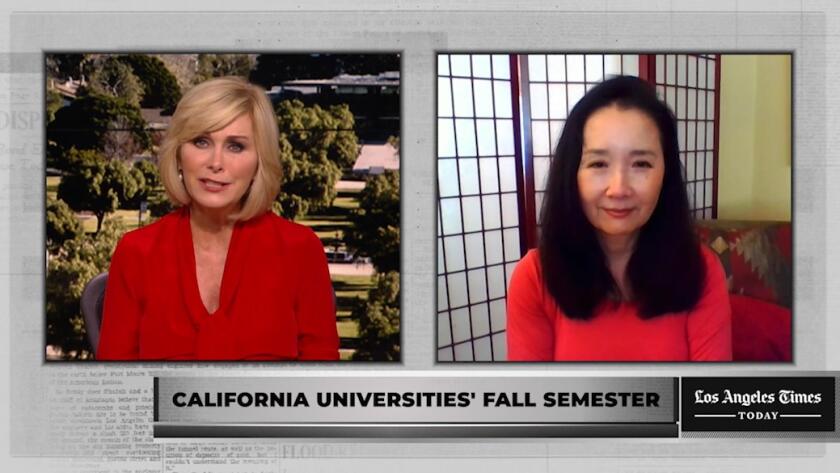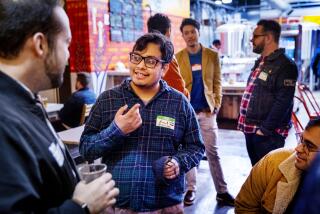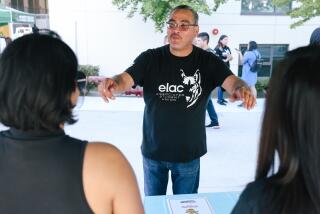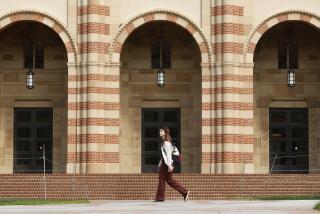California colleges in last-minute scramble to open without state guidance
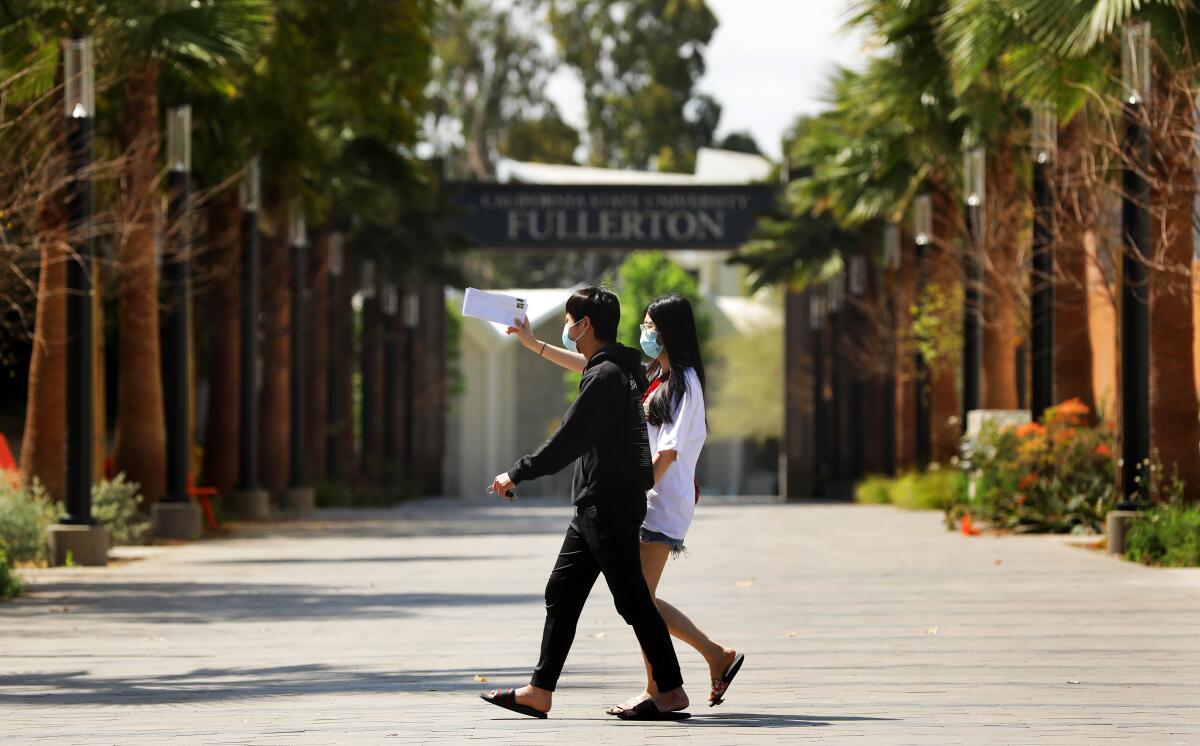
- Share via
Just days before the fall semester is set to begin, California colleges and universities are scrambling to finalize reopening plans that affect thousands of students as top leaders say the state’s lack of guidance for weeks has frustrated efforts to bring back limited in-person learning and dorm living.
Many campuses, including USC and Claremont McKenna, say the lack of clear and timely state guidance has caused them to spend enormous energy and money preparing for varying reopening scenarios — without knowing what will be allowed amid a surge of COVID-19 infections.
The uncertainty has resulted in a “wild array of different configurations of approaches and solutions” among campuses, according to Hiram Chodosh, president of Claremont McKenna College.
A spokesman for Gov. Gavin Newsom said the guidance will be released by the California Department of Health on Friday morning, but did not respond to questions about the delay.
Barbara Ferrer, L.A. County’s public health director, said this week that care must be taken because colleges and universities are “high-risk settings” for the spread of COVID-19. She noted that outbreaks have occurred in connection with USC at three fraternities and among a group of graduate students, as well as among UCLA football players.
“We do look forward to planning for the day when college campuses can reopen and bring students and faculty back,” she said. “But we will need to wait until the state releases their protocols before we know what the timeline will look like here in L.A. County.”
But colleges couldn’t wait.
Several institutions had planned to offer hybrid instruction and campus housing with strict safety protocols for masks, distancing, testing and tracing. But the lack of state authorization for those plans, even as fall return dates inch ever closer, prompted many to abruptly change gears.
On Wednesday, USC throttled back its reopening plan even further, and announced it would begin Aug. 17 with fully remote instruction, with limited exceptions for clinical instruction. The university asked students to delay returning to campus housing — just days before some of them were scheduled to arrive.
The university said more ambitious reopening plans to allow as many as 20% of classes to meet in person and students to live in single-occupancy dorms had not received state and county approval as expected.
“We know the lack of certainty has been frustrating for many of you, as well as our own teams, who keep planning and then re-planning for the 2020 fall semester,” USC Provost Charles F. Zukoski and David Wright, senior vice president of administration, wrote in the campus message. “The truth is the pandemic is not going away anytime soon, and we must adapt to the changing conditions and continue to hold the health and safety of our USC community paramount.”
In his July 24 message to the campus community, Chodosh pointedly noted that Claremont McKenna would not be allowed to resume in-person instruction or most on-campus housing as planned because of recent, substantial increases in COVID-19 cases “and, even more decisively, the absence of necessary state and county authorization for residential, in-person higher education programs to reopen.”
The college had begun planning a fall return months ago, envisioning classes in larger spaces or outdoors, students in single rooms or small-group dorms, takeout food eaten outside with safe distances among friends. His campus plans far exceed Los Angeles County’s draft reopening protocols for colleges and universities, which Chodosh helped create as a member of the higher education task force.
He said failing to take “measured risks” to reopen and simply waiting for a vaccine was not a “sensible way to confront the challenge.”
Harvey Mudd College, another member of the seven-campus Claremont Colleges consortium, has spent several months and hundreds of thousands of dollars preparing to have students on campus, including accommodating them in single rooms and providing outdoor dining, according to President Maria Klawe. Most classes will be online, but students will be able to work together in person.
The small college has emphasized, however, that those plans are contingent on approval by the state.
Klawe said the campus will be ready to shift to fully remote instruction, with no students on campus, if necessary. “We’ve had to plan for both possibilities because we just don’t know,” she said.
For many students, the uncertainty has been wrenching. Catherine Amein, a fourth-year student in electrical and computer engineering at USC, said she was devastated by the university’s message this week that it would not reopen for in-person classes or campus housing for most students.
She said she had eagerly awaited the fall semester because some of her labs were going to be in-person — her academic performance suffered in the shift to online learning in March — and she was set to move into campus housing next week. Now, however, she faces what she called her “worst-case scenario” of fully remote learning and living at home with her parents in Florida.
Had the university made clear earlier on that a full shutdown was possible, she said, she probably would have taken a gap year and worked instead because her parents did not want to pay USC’s $60,000 annual tuition and fees for fully online instruction.
“To be honest, I’ve cried a lot about this,” she said. “I got my hopes up too soon and it feels like they keep getting crushed.”
Most of California’s public colleges scheduled to open in August, including those in the state’s vast community college system, had made decisions earlier to move online. California State University, the nation’s largest four-year college system, in May announced plans to cancel most in-person classes in the fall and instead offer instruction primarily online.
At the University of California, plans vary among campuses, although systemwide guidelines lay out standards for testing, tracing, masking and distancing protocols. UC Berkeley and UC Merced, which begin the fall semester this month, the first of the nine undergraduate campuses to restart, had hoped to open Aug. 26 with a mix of online and in-person classes.
University officials later dropped those plans as COVID-19 cases surged across California, but still plan to house some students in campus dorms.
UCLA, which doesn’t begin its fall quarter until September, announced it would reduce the share of classes it plans to hold in person or in hybrid form to only 8% from 15% to 20% of classes as previously planned. It still plans to open some campus housing.
Caltech, which has just 950 undergraduates but operates large research facilities, including NASA’s Jet Propulsion Laboratory, resumed in-person activities at most of its 300 laboratories two months ago, said Provost David Tirrell.
Officials at Caltech have consulted with Pasadena public health officials about its reopening plans, which he said would meet all of L.A. County’s draft guidelines. But he is unsure if the plans will be in compliance with the still-unknown state protocols.
“It’s been frustrating,” Tirrell said. “The whole situation has been uniquely challenging.”
Many independent and private colleges that originally said they planned to offer in-person instruction also switched as circumstances changed. These include California Baptist University, Concordia University and Fresno Pacific University.
The Master’s University in Santa Clarita, Dominican University of California in San Rafael and Biola University in La Mirada plan to hold in-person classes for students involved in “essential workforce” training, including nursing, occupational therapy, biology/chemistry, public health and education. They also plan to allow students to live in residence halls.
- Share via
Watch LA Times Today at 7 PM on Spectrum News 1 on channel 1, on Cox systems in Palos Verdes and Orange County on channel 99, and live stream on the Spectrum News App.
More to Read
Sign up for Essential California
The most important California stories and recommendations in your inbox every morning.
You may occasionally receive promotional content from the Los Angeles Times.

